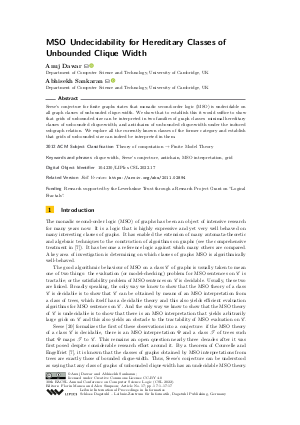MSO Undecidability for Hereditary Classes of Unbounded Clique Width
Authors
Anuj Dawar  ,
Abhisekh Sankaran
,
Abhisekh Sankaran 
-
Part of:
Volume:
30th EACSL Annual Conference on Computer Science Logic (CSL 2022)
Part of: Series: Leibniz International Proceedings in Informatics (LIPIcs)
Part of: Conference: Computer Science Logic (CSL) - License:
 Creative Commons Attribution 4.0 International license
Creative Commons Attribution 4.0 International license
- Publication Date: 2022-01-27
File

PDF
LIPIcs.CSL.2022.17.pdf
- Filesize: 0.76 MB
- 17 pages
Document Identifiers
Related Versions
- Full Version https://arxiv.org/abs/2011.02894
Subject Classification
ACM Subject Classification
- Theory of computation → Finite Model Theory
Keywords
- clique width
- Seese’s conjecture
- antichain
- MSO interpretation
- grid
Metrics
- Access Statistics
-
Total Accesses (updated on a weekly basis)
0Document
0Metadata
Abstract
Seese’s conjecture for finite graphs states that monadic second-order logic (MSO) is undecidable on all graph classes of unbounded clique-width. We show that to establish this it would suffice to show that grids of unbounded size can be interpreted in two families of graph classes: minimal hereditary classes of unbounded clique-width; and antichains of unbounded clique-width under the induced subgraph relation. We explore all the currently known classes of the former category and establish that grids of unbounded size can indeed be interpreted in them.
Cite As Get BibTex
Anuj Dawar and Abhisekh Sankaran. MSO Undecidability for Hereditary Classes of Unbounded Clique Width. In 30th EACSL Annual Conference on Computer Science Logic (CSL 2022). Leibniz International Proceedings in Informatics (LIPIcs), Volume 216, pp. 17:1-17:17, Schloss Dagstuhl – Leibniz-Zentrum für Informatik (2022)
https://doi.org/10.4230/LIPIcs.CSL.2022.17
BibTex
@InProceedings{dawar_et_al:LIPIcs.CSL.2022.17,
author = {Dawar, Anuj and Sankaran, Abhisekh},
title = {{MSO Undecidability for Hereditary Classes of Unbounded Clique Width}},
booktitle = {30th EACSL Annual Conference on Computer Science Logic (CSL 2022)},
pages = {17:1--17:17},
series = {Leibniz International Proceedings in Informatics (LIPIcs)},
ISBN = {978-3-95977-218-1},
ISSN = {1868-8969},
year = {2022},
volume = {216},
editor = {Manea, Florin and Simpson, Alex},
publisher = {Schloss Dagstuhl -- Leibniz-Zentrum f{\"u}r Informatik},
address = {Dagstuhl, Germany},
URL = {https://drops.dagstuhl.de/entities/document/10.4230/LIPIcs.CSL.2022.17},
URN = {urn:nbn:de:0030-drops-157373},
doi = {10.4230/LIPIcs.CSL.2022.17},
annote = {Keywords: clique width, Seese’s conjecture, antichain, MSO interpretation, grid}
}
Author Details
Funding
Research supported by the Leverhulme Trust through a Research Project Grant on "Logical Fractals".
References
- Aistis Atminas, Robert Brignall, Vadim V. Lozin, and Juraj Stacho. Minimal classes of graphs of unbounded clique-width defined by finitely many forbidden induced subgraphs. arXiv preprint, 2015. URL: http://arxiv.org/abs/1503.01628.
- Robert Brignall and Daniel Cocks. Uncountably many minimal hereditary classes of graphs of unbounded clique-width. arXiv preprint, 2021. URL: http://arxiv.org/abs/2104.00412.
-
Andrew Collins, Jan Foniok, Nicholas Korpelainen, Vadim Lozin, and Victor Zamaraev. Infinitely many minimal classes of graphs of unbounded clique-width. Discrete Applied Mathematics, 248:145-152, 2018.

-
Derek G Corneil and Udi Rotics. On the relationship between clique-width and treewidth. SIAM Journal on Computing, 34(4):825-847, 2005.

- Bruno Courcelle. The monadic second-order logic of graphs XV: On a conjecture by D. Seese. Journal of Applied Logic, 4(1):79-114, 2006. URL: https://doi.org/10.1016/j.jal.2005.08.004.
- Bruno Courcelle. From tree-decompositions to clique-width terms. Discret. Appl. Math., 248:125-144, 2018. URL: https://doi.org/10.1016/j.dam.2017.04.040.
-
Bruno Courcelle and Joost Engelfriet. Graph structure and monadic second-order logic: a language-theoretic approach, volume 138. Cambridge University Press, 2012.

- Bruno Courcelle, Joost Engelfriet, and Grzegorz Rozenberg. Handle-rewriting hypergraph grammars. Journal of Computer and System Sciences, 46(2):218-270, 1993. URL: https://doi.org/10.1016/0022-0000(93)90004-G.
- Bruno Courcelle and Sang il Oum. Vertex-minors, monadic second-order logic, and a conjecture by Seese. Journal of Combinatorial Theory, Series B, 97(1):91-126, 2007. URL: https://doi.org/10.1016/j.jctb.2006.04.003.
-
Bruno Courcelle and Stephan Olariu. Upper bounds to the clique width of graphs. Discrete Applied Mathematics, 101(1-3):77-114, 2000.

- Robert Ganian, Petr Hliněný, and Jan Obdrzálek. Clique-width: When hard does not mean impossible. In Thomas Schwentick and Christoph Dürr, editors, 28th International Symposium on Theoretical Aspects of Computer Science, STACS 2011, March 10-12, 2011, Dortmund, Germany, volume 9 of LIPIcs, pages 404-415. Schloss Dagstuhl - Leibniz-Zentrum für Informatik, 2011. URL: https://doi.org/10.4230/LIPIcs.STACS.2011.404.
-
Petr Hliněnỳ and Detlef Seese. Trees, grids, and MSO decidability: From graphs to matroids. Theoretical computer science, 351(3):372-393, 2006.

-
Wilfrid Hodges. Model theory. Cambridge University Press, 1993.

-
Nicholas Korpelainen. A new graph construction of unbounded clique-width. Electronic Notes in Discrete Mathematics, 56:31-36, 2016.

-
Vadim V. Lozin. Minimal classes of graphs of unbounded clique-width. Annals of Combinatorics, 15(4):707-722, 2011.

-
Vadim V. Lozin, Igor Razgon, and Viktor Zamaraev. Well-quasi-ordering does not imply bounded clique-width. In International Workshop on Graph-Theoretic Concepts in Computer Science, pages 351-359. Springer, 2015.

-
Jaroslav Nešetřil and Patrice Ossona De Mendez. Sparsity: graphs, structures, and algorithms, volume 28. Springer Science & Business Media, 2012.

-
Sang-il Oum and Paul Seymour. Approximating clique-width and branch-width. Journal of Combinatorial Theory, Series B, 96(4):514-528, 2006.

- Neil Robertson and P.D. Seymour. Graph minors. XX. Wagner’s conjecture. Journal of Combinatorial Theory, Series B, 92(2):325-357, 2004. Special Issue Dedicated to Professor W.T. Tutte. URL: https://doi.org/10.1016/j.jctb.2004.08.001.
-
Detlef Seese. The structure of the models of decidable monadic theories of graphs. Annals of pure and applied logic, 53(2):169-195, 1991.

